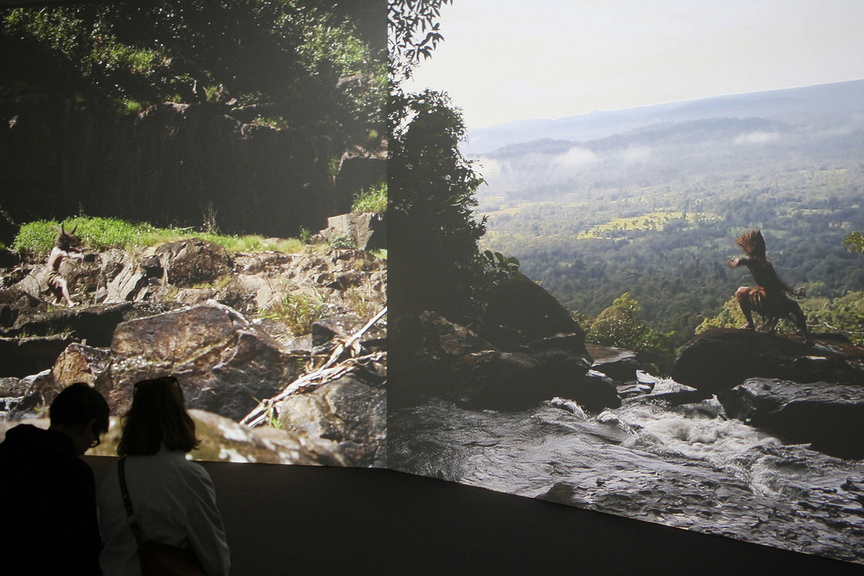
R
E
V N
E
X
T
Although Documenta in Kassel has downplayed the title “Learning from Athens,” it features an appropriate work, MARTA MINUJÍN’s The Parthenon of Books (2017), which faces the neoclassical Fridericianum, one of the oldest museums in Europe. Hard to see during the day, the tower on the right of the building is giving off whisps of white smoke, DANIEL KNOOR’s Expiration Movement (2017). All photos by HG Masters for ArtAsiaPacific.
What is Documenta 14 in Kassel about? The title of act one in Greece was “Learning from Athens,” but that theme seems to have been jettisoned here in Germany—it makes no appearance in the limited printed material offered to visitors. Looking at the show itself, its subjects are radically different from venue to venue. How those strands might come together isn’t clear yet. On my first day, I visited the Neue Neue Galerie, which contained a mix of responses to contemporary Europe’s multi-ethnic cultural conditions in light of its postwar history, and the Fridericianum, which presented an overview of post-1960s Greek art with some international insertions. On the second day, I saw four more venues: the Naturkundemuseum im Ottoneum; Documenta Halle; Westpavilion in the Orangerie; and the Neue Galerie. The exhibits in those venues yielded many more topics but didn’t not how they relate to one another— except through the tortured arc of Germany’s 20th-century history.
The Naturkundemuseum im Ottoneum was used once again—as it had been in previous editions—for projects exploring land, nature and indigenous concerns. This made for some uncomfortable (mis)perceptions. Doesn’t it seem almost classically ethnographic to show works like Khvay Samnang’s two-channel video Preah Kunlong (2017), which depicts rituals of the indigenous Chong people in the southwestern Cambodian province of Koh Kong, and the mural work Composite Wall Panel: Reckitt’s Blue (2017) by indigenous Australian artist Dale Harding, in a natural history museum? Another opaque curatorial decision was to show together Lala Rukh’s posters from the Women’s Action Forum in Lahore and two sets of her delicately abstract works on paper with no explanation of their relationship, in Documenta Halle, a venue that dominated by works about music, sound and performance.
It started feel like the title of Documenta 14 in Kassel should be “Learning from Kassel,” especially with regards to the objects and histories at the Neue Galerie. Here the works began with the diverse assortment of objects about art as money and vice versa, including Benin bronzes that were expropriated by colonial powers. There were sections about radical and collective sound works; the trans- or “disfigured” body; and several rooms about abstraction emerging from specific historical contexts (what Maria Lind called “social abstraction” in the 11th Gwangju Biennale). Upstairs, Maria Eichhorn’s nine-part project “Rose Valland Institute” (2017) looks at unrecovered books and artworks looted by the Third Reich. This was followed by a heady string of rooms that narrated the story of Documenta’s founder Arnold Bode and the recuperation of works labeled “degenerate art” under the Nazi regime. Curators then traced that history back to the German Enlightenment values and the Romantic ethos that idealized the “classical beauty” of the ancient Greeks, which later morphed into ideals of racial purity that fueled incidents of racialized injustice in Germany and abroad. At every step in the Neue Galerie, artworks served as evidence in an implicit—and yet frustratingly unarticulated—thesis. This didactic approach to objects as historical evidence, rather than existing as things in themselves, lies at the center of a Documenta that, in artistic director Adam Szymczyk’s few remarks at the press conference he maintains is “against interpretation, or at least against literal interpretation.”
HG Masters is editor at large of ArtAsiaPacific.
Documenta 14’s program in Kassel runs from June 10 to September 17, 2017.To read more of ArtAsiaPacific’s articles, visit our Digital Library.




